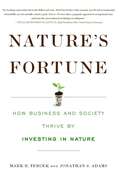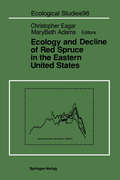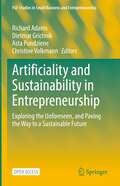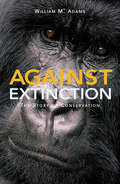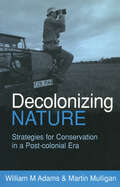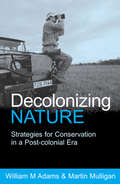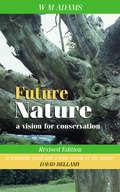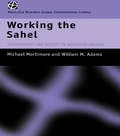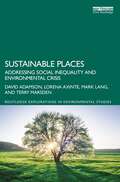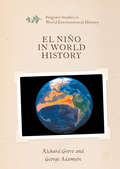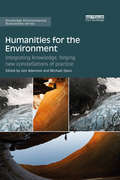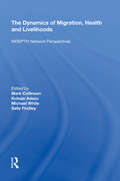- Table View
- List View
Nature's Fortune: How Business and Society Thrive by Investing in Nature
by Jonathan S. Adams Mark R. TercekWhat is nature worth? The answer to this question-which traditionally has been framed in environmental terms-is revolutionizing the way we do business.In Nature's Fortune, Mark Tercek, CEO of The Nature Conservancy and former investment banker, and science writer Jonathan Adams argue that nature is not only the foundation of human well-being, but also the smartest commercial investment any business or government can make. The forests, floodplains, and oyster reefs often seen simply as raw materials or as obstacles to be cleared in the name of progress are, instead, as important to our future prosperity as technology or law or business innovation.Who invests in nature, and why? What rates of return can it produce? When is protecting nature a good investment? With stories from the South Pacific to the California coast, from the Andes to the Gulf of Mexico and even to New York City, Nature's Fortune shows how viewing nature as green infrastructure allows for breakthroughs not only in conservation-protecting water supplies; enhancing the health of fisheries; making cities more sustainable, livable and safe; and dealing with unavoidable climate change-but in economic progress, as well. Organizations obviously depend on the environment for key resources-water, trees, and land. But they can also reap substantial commercial benefits in the form of risk mitigation, cost reduction, new investment opportunities, and the protection of assets. Once leaders learn how to account for nature in financial terms, they can incorporate that value into the organization's decisions and activities, just as habitually as they consider cost, revenue, and ROI. Such a rethinking of "natural capital”-nature as a quantifiable asset-can not only increase profitability, but provide crucial protection against the kinds of climate change-driven phenomena-like devastating drought and hundred-year floods-that are no longer the stuff of speculation.A must-read for business leaders, CEOs, investors, and environmentalists alike, Nature's Fortune offers an essential guide to the world's economic-and environmental-well-being.
Ecology and Decline of Red Spruce in the Eastern United States (Ecological Studies #96)
by Mary B. Adams C. Cogbill E. R. Cook D. H. DeHayes Christopher Eagar I. J. Fernandez K. F. Jensen A. H. Johnson D. W. Johnson R. J. Kohut S. B. McLaughlin M.M. Miller-Weeks V. A. Mohnen N. S. Nicholas D. R. Peart G. A. Schier T. G. Siccama P. S. White S. M. ZedakerIn the early 1980s there were several published reports of recent, unexplained increases in mortality of red spruce in the Adirondack Mountains and the northern Appalachian Mountains of the eastern United States. These reports coincided with documentation of reductions in radial growth of several species of pine in the southeastern United States, and with the severe, rapid, and widespread decline of Norway spruce, silver fir, and some hardwoods in central Europe. In all of these instances, atmospheric deposition was hypothesized as the cause of the decline. (Throughout this volume, we use the term "decline" to refer to a loosely synchronized regional-scale deterioration of tree health which is brought about by a combination of stress factors. These may be biotic or abiotic in nature, and the combinations may differ from site to site. ) Heated public debate about the causes and possible cures for these forest declines ensued. Through the course of this debate, it became clear that information about forest health and air pollution effects on forests was inadequate to meet policymakers' needs. Ecology and Decline of Red Spruce in the Eastern United States addresses that gap for eastern spruce fir forests and represents the culmination of a great deal of research conducted in recent years. The focus is on red spruce because the decline of red spruce was both dramatic and inexplicable and because of the great amount of information gathered on red spruce.
Atlantic Reverberations: French Representations of an American Presidential Election
by Paul C. AdamsThe 2004 US election provided French citizens and their media with a springboard for re-conceiving 'self' and 'other'. Given its prominent opposition to recent US foreign policy such as the invasion of Iraq, a volley of insults and caustic remarks reverberated between France and the US. French observers linked the Bush administration's policies to particular groups and regions within the US, to a democratic deficit, to a perceived threat of US collapse and to the need for a stronger Europe. By examining how the French media - newspapers, television, the internet and scholarly research - represented the election from a critical geopolitical perspective, this book provides the first major in-depth study of views of the US in contemporary foreign media.
Atlantic Reverberations: French Representations of an American Presidential Election
by Paul C. AdamsThe 2004 US election provided French citizens and their media with a springboard for re-conceiving 'self' and 'other'. Given its prominent opposition to recent US foreign policy such as the invasion of Iraq, a volley of insults and caustic remarks reverberated between France and the US. French observers linked the Bush administration's policies to particular groups and regions within the US, to a democratic deficit, to a perceived threat of US collapse and to the need for a stronger Europe. By examining how the French media - newspapers, television, the internet and scholarly research - represented the election from a critical geopolitical perspective, this book provides the first major in-depth study of views of the US in contemporary foreign media.
Routledge Handbook of Media Geographies
by Paul C. AdamsThis Handbook offers a comprehensive overview of media geography, focusing on a range of different media viewed through the lenses of human geography and media theory. It addresses the spatial practices and processes associated with both old and new media, considering "media" not just as technologies and infrastructures, but also as networks, systems and assemblages of things that come together to enable communication in the real world. With contributions from academics specializing in geography and media studies, the Routledge Handbook of Media Geographies summarizes the recent developments in the field and explores key questions and challenges affecting various groups, such as women, minorities, and persons with visual impairment. It considers geographical aspects of disruptive media uses such as hacking, fake news, and racism. Written in an approachable style, chapters consider geographies of users, norms, rules, laws, values, attitudes, routines, customs, markets, and power relations. They shed light on how mobile media make users vulnerable to tracking and surveillance but also facilitate innovative forms of mobility, space perception and placemaking. Structured in four distinct sections centered around "control and access to digital media," "mass media," "mobile media and surveillance" and "media and the politics of knowledge," the Handbook explores digital divides and other manifestations of the uneven geographies of power. It also includes an overview of the alternative social media universe created by the Chinese government. Media geography is a burgeoning field of study that lies at the intersections of various social sciences, including human geography, political science, sociology, anthropology, communication/media studies, urban studies, and women and gender studies. Academics and students across these fields will greatly benefit from this Handbook.
Routledge Handbook of Media Geographies
by Paul C. Adams Barney WarfThis Handbook offers a comprehensive overview of media geography, focusing on a range of different media viewed through the lenses of human geography and media theory. It addresses the spatial practices and processes associated with both old and new media, considering "media" not just as technologies and infrastructures, but also as networks, systems and assemblages of things that come together to enable communication in the real world. With contributions from academics specializing in geography and media studies, the Routledge Handbook of Media Geographies summarizes the recent developments in the field and explores key questions and challenges affecting various groups, such as women, minorities, and persons with visual impairment. It considers geographical aspects of disruptive media uses such as hacking, fake news, and racism. Written in an approachable style, chapters consider geographies of users, norms, rules, laws, values, attitudes, routines, customs, markets, and power relations. They shed light on how mobile media make users vulnerable to tracking and surveillance but also facilitate innovative forms of mobility, space perception and placemaking. Structured in four distinct sections centered around "control and access to digital media," "mass media," "mobile media and surveillance" and "media and the politics of knowledge," the Handbook explores digital divides and other manifestations of the uneven geographies of power. It also includes an overview of the alternative social media universe created by the Chinese government. Media geography is a burgeoning field of study that lies at the intersections of various social sciences, including human geography, political science, sociology, anthropology, communication/media studies, urban studies, and women and gender studies. Academics and students across these fields will greatly benefit from this Handbook.
Artificiality and Sustainability in Entrepreneurship: Exploring the Unforeseen, and Paving the Way to a Sustainable Future (FGF Studies in Small Business and Entrepreneurship)
by Richard Adams Dietmar Grichnik Asta Pundziene Christine VolkmannThis open access edited volume explores the past, present, and future of artificiality and sustainability in entrepreneurship – the unforeseen consequences and ways to advance to a sustainable future. In particular, it connects artificiality, sustainability and entrepreneurship, intertwining artificial with the specific phenomenon of those novel digital technologies that provoke continuous and significant change in our lives and business. Unlike digital entrepreneurship research, which focuses on digital technology development and management, this book covers processes and mechanisms of sustainable adaptability of entrepreneurs, the business logic of start-ups, and the collaborative behaviours under the mass digital transformation, including the prevalence of artificial intelligence. Some of the questions that this book answers are as follows: How has entrepreneurship reacted to such challenges previously? What lessons have been learned and need to be carried forward? How can entrepreneurship and the artefacts of entrepreneurship respond to current challenges? What should be the mindset of the entrepreneur to assure sustainable adaptation? How to embrace and embed the new business logic?
Against Extinction: The Story of Conservation
by William Bill Adams'Conservation in the 21st century needs to be different and this book is a good indicator of why.' Bulletin of British Ecological Society Against Extinction tells the history of wildlife conservation from its roots in the 19th century, through the foundation of the Society for the Preservation of the Wild Fauna of the Empire in London in 1903 to the huge and diverse international movement of the present day. It vividly portrays conservation's legacy of big game hunting, the battles for the establishment of national parks, the global importance of species conservation and debates over the sustainable use of and trade in wildlife. Bill Adams addresses the big questions and ideas that have driven conservation for the last 100 years: How can the diversity of life be maintained as human demands on the Earth expand seemingly without limit? How can preservation be reconciled with human rights and the development needs of the poor? Is conservation something that can be imposed by a knowledgeable elite, or is it something that should emerge naturally from people's free choices? These have never been easy questions, and they are as important in the 21st century as at any time in the past. The author takes us on a lively historical journey in search of the answers.
Against Extinction: The Story of Conservation
by William Bill Adams'Conservation in the 21st century needs to be different and this book is a good indicator of why.' Bulletin of British Ecological Society Against Extinction tells the history of wildlife conservation from its roots in the 19th century, through the foundation of the Society for the Preservation of the Wild Fauna of the Empire in London in 1903 to the huge and diverse international movement of the present day. It vividly portrays conservation's legacy of big game hunting, the battles for the establishment of national parks, the global importance of species conservation and debates over the sustainable use of and trade in wildlife. Bill Adams addresses the big questions and ideas that have driven conservation for the last 100 years: How can the diversity of life be maintained as human demands on the Earth expand seemingly without limit? How can preservation be reconciled with human rights and the development needs of the poor? Is conservation something that can be imposed by a knowledgeable elite, or is it something that should emerge naturally from people's free choices? These have never been easy questions, and they are as important in the 21st century as at any time in the past. The author takes us on a lively historical journey in search of the answers.
Decolonizing Nature: Strategies for Conservation in a Post-colonial Era
by William Bill Adams Martin MulliganBritish imperialism was almost unparalleled in its historical and geographical reach, leaving a legacy of entrenched social transformation in nations and cultures in every part of the globe. Colonial annexation and government were based on an all-encompassing system that integrated and controlled political, economic, social and ethnic relations, and required a similar annexation and control of natural resources and nature itself. Colonial ideologies were expressed not only in the progressive exploitation of nature but also in the emerging discourses of conservation. At the start of the 21st century, the conservation of nature is of undiminished importance in post-colonial societies, yet the legacy of colonial thinking endures. What should conservation look like today, and what (indeed, whose) ideas should it be based upon? Decolonizing Nature explores the influence of the colonial legacy on contemporary conservation and on ideas about the relationships between people, polities and nature in countries and cultures that were once part of the British Empire. It locates the historical development of the theory and practice of conservation - at both the periphery and the centre - firmly within the context of this legacy, and considers its significance today. It highlights the present and future challenges to conservationists of contemporary global neo-colonialism The contributors to this volume include both academics and conservation practitioners. They provide wide-ranging and insightful perspectives on the need for, and practical ways to achieve new forms of informed ethical engagement between people and nature.
Decolonizing Nature: Strategies for Conservation in a Post-colonial Era
by William Bill Adams Martin MulliganBritish imperialism was almost unparalleled in its historical and geographical reach, leaving a legacy of entrenched social transformation in nations and cultures in every part of the globe. Colonial annexation and government were based on an all-encompassing system that integrated and controlled political, economic, social and ethnic relations, and required a similar annexation and control of natural resources and nature itself. Colonial ideologies were expressed not only in the progressive exploitation of nature but also in the emerging discourses of conservation. At the start of the 21st century, the conservation of nature is of undiminished importance in post-colonial societies, yet the legacy of colonial thinking endures. What should conservation look like today, and what (indeed, whose) ideas should it be based upon? Decolonizing Nature explores the influence of the colonial legacy on contemporary conservation and on ideas about the relationships between people, polities and nature in countries and cultures that were once part of the British Empire. It locates the historical development of the theory and practice of conservation - at both the periphery and the centre - firmly within the context of this legacy, and considers its significance today. It highlights the present and future challenges to conservationists of contemporary global neo-colonialism The contributors to this volume include both academics and conservation practitioners. They provide wide-ranging and insightful perspectives on the need for, and practical ways to achieve new forms of informed ethical engagement between people and nature.
Future Nature: A Vision for Conservation
by W.M. AdamsThe countryside is changing faster than ever. Fifty years of conservation achievements in the UK are now being confronted by a new complexion of economic forces that are driving change in the countryside. At the same time new ideas in conservation are altering the role that conservation is being asked to play in negotiating the transition from past to future. This revised edition of Bill Adams classic work Future Nature tackles the new challenges in the countryside and wildlife conservation head-on through a new Introduction and Postscript with updated arguments about naturalness and our social engagement with nature, and complemented by a new Foreword by Adrian Phillips. Concepts such as biodiversity and sustainability, and changes in our understanding, appreciation and concern for nature, offer unprecedented opportunities. Bill Adams explores the scientific, cultural and economic significance of conservation. He argues that conservation must move beyond the boundaries of parks and reserves to embrace the whole countryside. The importance of conservation for the future is enormous. It holds the potential to create new spaces for nature, both in the landscape and in our lives and imaginations. This factual, beautifully written and thought-provoking book offers a fundamental reassessment of conservation, its importance, and how to achieve it. Published with BANC
Future Nature: A Vision for Conservation
by W.M. AdamsThe countryside is changing faster than ever. Fifty years of conservation achievements in the UK are now being confronted by a new complexion of economic forces that are driving change in the countryside. At the same time new ideas in conservation are altering the role that conservation is being asked to play in negotiating the transition from past to future. This revised edition of Bill Adams classic work Future Nature tackles the new challenges in the countryside and wildlife conservation head-on through a new Introduction and Postscript with updated arguments about naturalness and our social engagement with nature, and complemented by a new Foreword by Adrian Phillips. Concepts such as biodiversity and sustainability, and changes in our understanding, appreciation and concern for nature, offer unprecedented opportunities. Bill Adams explores the scientific, cultural and economic significance of conservation. He argues that conservation must move beyond the boundaries of parks and reserves to embrace the whole countryside. The importance of conservation for the future is enormous. It holds the potential to create new spaces for nature, both in the landscape and in our lives and imaginations. This factual, beautifully written and thought-provoking book offers a fundamental reassessment of conservation, its importance, and how to achieve it. Published with BANC
Working the Sahel
by W.M. Adams M.J. MortimoreThis book looks at how people in the semi-arid conditions of the Sahel cope with their harsh environment. It draws on four years of field research with farmers in the Sahelian region and builds on work with these communities over several decades. Reporting on studies of four village communities, it shows how people work to achieve sustainable livelihoods and emphasises that there can be development without disaster.
Working the Sahel
by W.M. Adams M.J. MortimoreThis book looks at how people in the semi-arid conditions of the Sahel cope with their harsh environment. It draws on four years of field research with farmers in the Sahelian region and builds on work with these communities over several decades. Reporting on studies of four village communities, it shows how people work to achieve sustainable livelihoods and emphasises that there can be development without disaster.
Sustainable Places: Addressing Social Inequality and Environmental Crisis (Routledge Explorations in Environmental Studies)
by David Adamson Lorena Axinte Mark Lang Terry MarsdenThis book calls for more holistic place-based action to address the social and environmental crisis, deploying the Deep Place approach as one contribution to the toolbox of actions that will underpin the UN Decade of Action towards the Sustainable Development Goals. The authors suggest that ‘place’ is a critical window on how to conceive a resolution to the multiple and overlapping crises. As well as diagnosing the problem (the world as it is), this book also offers a normative advocacy (the world as it could/should be and proposed pathways to get there). A series of ‘Deep Place’ case studies from the UK, Australia, and Vanuatu help to illustrate this approach. Ultimately, the book argues for the need for a real and green ‘new deal’ and identifies what this should be like. It suggests that a new economic order, whilst eventually inevitable, requires radical change. This will not be easy but will be essential given the current impasse, caused, not least by the conjunction of carbon-based, neoliberal capitalism in crisis and the multifactorial global ecological crisis. Ultimately, it concludes that there is a need to develop a new model of ‘regenerative collectivism’ to overcome these crises. This book will be of interest to academics, policy practitioners, and social and climate justice advocates/activists.
Sustainable Places: Addressing Social Inequality and Environmental Crisis (Routledge Explorations in Environmental Studies)
by David Adamson Lorena Axinte Mark Lang Terry MarsdenThis book calls for more holistic place-based action to address the social and environmental crisis, deploying the Deep Place approach as one contribution to the toolbox of actions that will underpin the UN Decade of Action towards the Sustainable Development Goals. The authors suggest that ‘place’ is a critical window on how to conceive a resolution to the multiple and overlapping crises. As well as diagnosing the problem (the world as it is), this book also offers a normative advocacy (the world as it could/should be and proposed pathways to get there). A series of ‘Deep Place’ case studies from the UK, Australia, and Vanuatu help to illustrate this approach. Ultimately, the book argues for the need for a real and green ‘new deal’ and identifies what this should be like. It suggests that a new economic order, whilst eventually inevitable, requires radical change. This will not be easy but will be essential given the current impasse, caused, not least by the conjunction of carbon-based, neoliberal capitalism in crisis and the multifactorial global ecological crisis. Ultimately, it concludes that there is a need to develop a new model of ‘regenerative collectivism’ to overcome these crises. This book will be of interest to academics, policy practitioners, and social and climate justice advocates/activists.
El Niño in World History (Palgrave Studies in World Environmental History)
by George Adamson Richard GroveThis book examines the role of the El Niño Southern Oscillation (ENSO) in society. Throughout human history, large or recurrent El Niños could cause significant disruption to societies and in some cases even contribute to political change. Yet it is only now that we are coming to appreciate the significance of the phenomenon. In this volume, Richard Grove and George Adamson chart the dual history of El Niño: as a global phenomenon capable of devastating weather extremes and, since the 18th century, as a developing idea in science and society. The chapters trace El Niño’s position in world history from its role in the revolution in Australian Aboriginal Culture at 5,000 BP to the 2015-16 ‘Godzilla’ event. It ends with a discussion of El Niño in the current media, which is as much a product of the public imagination as it is a natural process.
Humanities for the Environment: Integrating knowledge, forging new constellations of practice (Routledge Environmental Humanities)
by Joni Adamson Michael DavisHumanities for the Environment, or HfE, is an ambitious project that from 2013-2015 was funded by a generous grant from the Andrew W. Mellon Foundation. The project networked universities and researchers internationally through a system of 'observatories'. This book collects the work of contributors networked through the North American, Asia-Pacific, and Australia-Pacific observatories. Humanities for the Environment showcases how humanists are working to 'integrate knowledges' from diverse cultures and ontologies and pilot new 'constellations of practice' that are moving beyond traditional contemplative or reflective outcomes (the book, the essay) towards solutions to the greatest social and environmental challenges of our time. With the still controversial concept of the 'Anthropocene' as a starting point for a widening conversation, contributors range across geographies, ecosystems, climates and weather regimes; moving from icy, melting Arctic landscapes to the bleaching Australian Great Barrier Reef, and from an urban pedagogical 'laboratory' in Phoenix, Arizona to Vatican City in Rome. Chapters explore the ways in which humanists, in collaboration with communities and disciplines across academia, are responding to warming oceans, disappearing islands, collapsing fisheries, evaporating reservoirs of water, exploding bushfires, and spreading radioactive contamination. This interdisciplinary work will be of great interest to scholars in the humanities, social sciences, and sciences interested in interdisciplinary questions of environment and culture.
Humanities for the Environment: Integrating knowledge, forging new constellations of practice (Routledge Environmental Humanities)
by Joni Adamson Michael DavisHumanities for the Environment, or HfE, is an ambitious project that from 2013-2015 was funded by a generous grant from the Andrew W. Mellon Foundation. The project networked universities and researchers internationally through a system of 'observatories'. This book collects the work of contributors networked through the North American, Asia-Pacific, and Australia-Pacific observatories. Humanities for the Environment showcases how humanists are working to 'integrate knowledges' from diverse cultures and ontologies and pilot new 'constellations of practice' that are moving beyond traditional contemplative or reflective outcomes (the book, the essay) towards solutions to the greatest social and environmental challenges of our time. With the still controversial concept of the 'Anthropocene' as a starting point for a widening conversation, contributors range across geographies, ecosystems, climates and weather regimes; moving from icy, melting Arctic landscapes to the bleaching Australian Great Barrier Reef, and from an urban pedagogical 'laboratory' in Phoenix, Arizona to Vatican City in Rome. Chapters explore the ways in which humanists, in collaboration with communities and disciplines across academia, are responding to warming oceans, disappearing islands, collapsing fisheries, evaporating reservoirs of water, exploding bushfires, and spreading radioactive contamination. This interdisciplinary work will be of great interest to scholars in the humanities, social sciences, and sciences interested in interdisciplinary questions of environment and culture.
Born Free: The Story of Elsa (Pan 70th Anniversary #81)
by Joy AdamsonFifty years ago Joy Adamson first introduced to the world the story of her life alongside Elsa the lioness, whom she had rescued as an orphaned cub, and raised at her home in Kenya. But as Elsa had been born free, Joy made the heartbreaking decision that she must be returned to the wild when she was old enough to fend for herself. Since the first publication of Born Free and its sequels Living Free and Forever Free, generations of readers have been enchanted, inspired and moved by these books’ uplifting charm and the remarkable interaction between Joy and Elsa. Millions have also come to know and love Born Free through the immortal film starring Virginia McKenna and Bill Travers. But here is the chance to rediscover the original story in this 50th anniversary edition, in the words of the woman who reared Elsa and walked with the lions.
Climate Change and the Future of Sustainability: The Impact on Renewable Resources
by Muyiwa AdaramolaThis title includes a number of Open Access chapters. Renewable resources such as wind, solar, and geothermal are often perceived as being the answer to the fossil fuel crisis. Ironically, however, climate change may also negatively impact on these energy sources. All forms of renewable energy are somewhat sensitive to climate variation. This new compendium looks at the impact of renewable resources on climate change from a variety of perspectives.
Climate Change and the Future of Sustainability: The Impact on Renewable Resources
by Muyiwa AdaramolaThis title includes a number of Open Access chapters. Renewable resources such as wind, solar, and geothermal are often perceived as being the answer to the fossil fuel crisis. Ironically, however, climate change may also negatively impact on these energy sources. All forms of renewable energy are somewhat sensitive to climate variation. This new compendium looks at the impact of renewable resources on climate change from a variety of perspectives.
The Dynamics of Migration, Health and Livelihoods: INDEPTH Network Perspectives
by Kubaje AdazuUsing INDEPTH's multi-site network to provide new demographic insights into population variables, this book provides a new perspective on migration, health and livelihood's interaction over time. The book starts with providing a conceptual and methodological framework to inform the epidemiological studies that are clustered into two themes, showing the dynamics of migration with either household livelihoods or individual health outcomes. The findings demonstrate the important cross-national regularities in human migration. The contributed chapters also exemplify the fact that the impacts of migration can be either positive or negative for sending and/or receiving communities, depending on the issues at hand and the type of migration under consideration.
The Dynamics of Migration, Health and Livelihoods: INDEPTH Network Perspectives
by Kubaje AdazuUsing INDEPTH's multi-site network to provide new demographic insights into population variables, this book provides a new perspective on migration, health and livelihood's interaction over time. The book starts with providing a conceptual and methodological framework to inform the epidemiological studies that are clustered into two themes, showing the dynamics of migration with either household livelihoods or individual health outcomes. The findings demonstrate the important cross-national regularities in human migration. The contributed chapters also exemplify the fact that the impacts of migration can be either positive or negative for sending and/or receiving communities, depending on the issues at hand and the type of migration under consideration.
